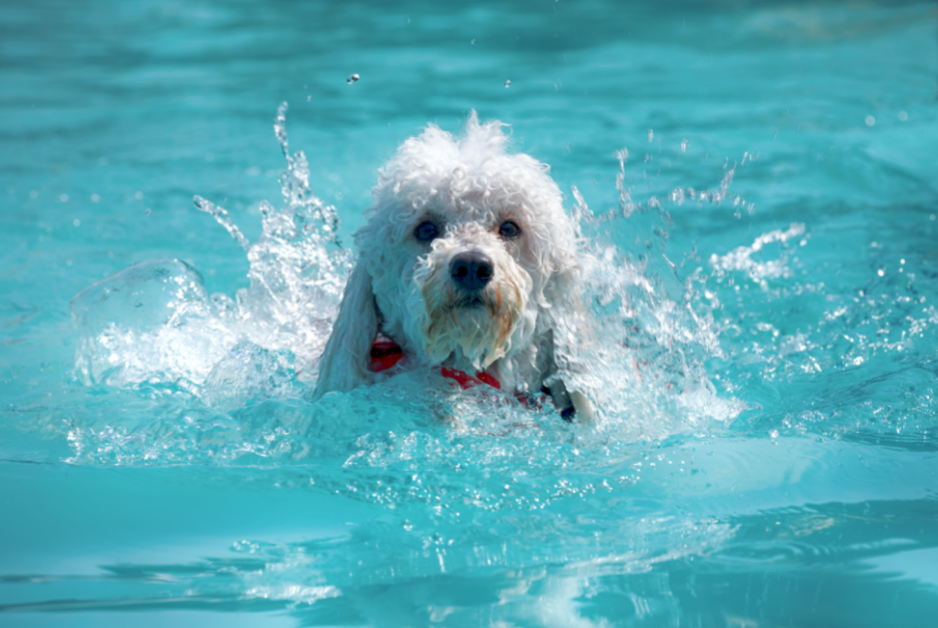Do you know what the original purpose of the Poodle was?

Originally, the purpose of the Poodle was to hunt waterfowl, i.e., ducks and birds! This means they would have to occasionally go in the water and get them.
In fact, their name in German is Pudelin which means to splash in the water! Since then till now, Poodles have carried their love to swim in their DNA!

Read our Smart Poodles - Smart Tricks eBook for only $2.99
Dive into a treasure trove of engaging tricks and tips designed specifically for your poodle!
Don’t be surprised if you see Poodles splashing around in the water in your local park or beach.
Yes, this is a perfect breed to own if you live next to the beach or a river, for them to exert their energy and you both to enjoy nature around you.
However, it’s important that a Poodle is not out in the sun too long when they’re in the water as they can easily get sunburnt! Similarly, the more exposed they are to the sun, the higher chances they have of getting skin cancer, so take caution!
What Will You Learn? 👇
Historic haircut for water
Nowadays, you will often see Poodles having fancy haircuts and strutting about at dog shows. In fact, there are over a whopping 140 different types of haircuts! Today all the haircuts are designed to make a Poodle look cute and cuddly.
But, back then, that wasn’t the reason a Poodle had haircuts. Do you know why they got haircuts back then?
Can you guess?
Oh, we’ll save you time! The reason Poodles got haircuts in the olden days was to help them swim. Their haircuts paid specific focus to their legs and back, where hairs were meticulously trimmed to make them more streamlined.
The reason barbers trimmed these two areas as it also made them more lightweight and to stop any debris attaching to their hair while swimming. Plus, Poodles also had fluff spots that sat on top of their main organs and joints, which allowed them to be protected from cold water. Plus, the Poodle’s iconic pompom on their tail would help breeders identify where they are hunting.
More about their coat

Now you have a basic insight into why a Poodle had haircuts; there are more qualities than you may realize will help them swim. First up is their coat! A Poodle’s coat is full of hair, dense, smooth, curly, and water-resistant.
Yes, they’re water resistant! This means that when wet, their hair will not weigh them down and pull them under the water and allow them to swim easily.
Unlike other breeds, a Poodle is renowned for having a single coat, whereas others have two.
Similarly, Poodles have the most webbing between their toes and other parts of their bodies than other dog breeds and us humans! This brilliant feature enables them to paddle effectively through the water like flippers. Plus, these features are the same across every Poodle the Standard, Miniature, and Toy!
Energy level
If you’re thinking about owning a Poodle, you must have time on your hands to make sure it exhausts all of its energy levels! This dog has a high amount of energy and needs plenty of exercises to keep its mind and body stimulated.
If you don’t do this, a Poodle can become easily irritated and develop self-destructive behaviors such as aggression, barking, and boredom chewing to relieve their energy.
Swimming and allowing your Poodle to splash or play in the water is one easy yet fantastic way of them exerting their energy level! You can even combine mental stimulation with physical by training them in the water also. Since Poodles are highly intelligent, training will enable them to feel challenged and also allow them to cool off while doing so.
Which is the best type of Poodle for swimming?
While all three types of Poodle hold great qualities for swimming, their height can come into play at times. To understand what we mean, let’s review the dimensions for the Standard, Miniature, and Toy.
Standard Poodle: This is the biggest type of Poodle out of the three. On average, they can grow to 24.5-32 inches/62-81cm and weigh between 45-70lbs/20.4-31.7kg.
Miniature Poodle: The Minature Poodle, on average, can grow between 11-15inches/27-38 cm and can grow up to 15-17Ibs/ 6.8kg-7.1kg.
Toy Poodle: Out of all three Poodles, the Toy Poodle is the smallest and can grow up to 8-10inches/20.32-25.4cm tall. Similarly, it can also weigh on average 6-10lbs/2.7-4.5kg.
Now you have an idea behind all three breeds; you can probably see there’s a significant difference in height and weight, right?
Well, out of them all, the Standard tends to be the better swimmer. They’re often the most graceful and are stronger swimmers in the water. Similarly, the smaller ones such as the Miniature and Toy Poodle can become tired quicker in water due to their smaller size. If you own these types of Poodles, then you should be cautious taking them to swim in deep pools or deep areas of the river or sea.
Poodle in a swimming pool
If you want to take your Poodle into a swimming pool, be careful of the chlorine levels. This chemical isn’t that harmful to your Poodle, but if there are large amounts in the water, they could be at risk. To reduce their risk of them drinking water from the pool, you can put a bowl of water next to the pool, so they’re encouraged to drink that.
You should also wash your Poodle straight away after they’ve been in a swimming pool. If chlorine remains on their hair, it can cause their skin to dry out and strip natural oils away from their hair . You can also put in leave-in conditioner in their hair before they go into the water and after to make sure their natural oils are kept in place. To have a better idea, you can also speak to a veterinarian who will advise which is the better one to use.
Ear infections in water
All dogs have a risk of getting ear infections, but even more so when Poodles enter the water. Their long floppy ears can cause dampness, dirt, and chlorine (if in a swimming pool) to get trapped inside. To reduce their risk of ear infection, you must wipe their ears with a towel after they’ve swum in the water.
As a dog owner, you should also clean their ears every week using a gentle cloth. To do this, you will reduce their risk of infection. Do look out for any redness, swelling, itchiness, and a strange smell. If you notice this, take them to the vets immediately.
5 steps on how to teach a Poodle to swim

Even though Poodles are born to swim, don’t just take them to a pool or river and expect the experience to go well. In fact, sometimes Poodles need to be shown as not all of them like water! Similarly, they may have different feelings towards it, and for that reason, you might have to teach them how to swim. You can do this by:
- Exposing them to the water: If your Poodle has not had any interaction with water other than drinking and when being washed, you will want to introduce it to water slowly. The good idea is to introduce it to sound, smells, and feelings surrounding water.
- Small steps: When you take them to swim, you should start at the shallow end of the sea or pool. This is even more important if your Poodle is a Miniature or Toy breed! It’s often best to get in the water first and then convince them to join you with a treat when they come in. Positive reinforcement will help them pick up the idea quickly.
- Gradually take them to the deep parts: Your Poodle trusts you! Therefore you should never take them further if they can’t cope with the existing depth. Ensure to stick by their side and look for signs of them retreating back to the shallow end. If they do this, they may be scared.
- Paddling is normal: If you see your Poodle paddling in the water, this is normal. They will do this when it’s too deep. Plus, it’s their instinct!
- Observe to see if they are fatigued: While Poodles do have a high amount of energy, you should look out for them getting tired. Swimming involves different muscles than those walking and uses up a lot of energy. Therefore you should pay careful attention; similarly, you should also not let the Poodle stay too long in the water.
Final thoughts
Overall, Poodles are born to love water! They were first bred to hunt ducks and birds; similarly, their hair was trimmed on their legs and back to make them more streamlined. Today Poodles aren’t kept as dogs to hunt, instead, they’re domesticated.
Just cause they have swimming in their DNA does not mean they will instantly like the water. Some Poodles might be afraid or hesitant towards the water; if so, you need to gradually introduce them to water. Don’t take
Marko is the founder and author at PoodleHQ, where he blends profound expertise with formal training in Animal Behavior and Canine Genetics. With multiple generations of poodles under his care, he’s a breed connoisseur, honored with the Canine Care Excellence Award and lauded by the International Pet Enthusiasts Association.


Yes! Our poodle loved the water last year, won’t go in a kiddy this year? Why is that?
It’s not uncommon for poodles to develop specific preferences or aversions over time. It’s possible that your poodle had a negative experience or encountered something that made them apprehensive about the kiddy pool this year.
I recommend gradually reintroducing the pool, using positive reinforcement and treats to create a positive association and help rebuild their confidence in the water.
Patience and gentle encouragement should help your poodle regain their love for the water.
YES! Why my poodle 🐩 is afraid of water this summer?